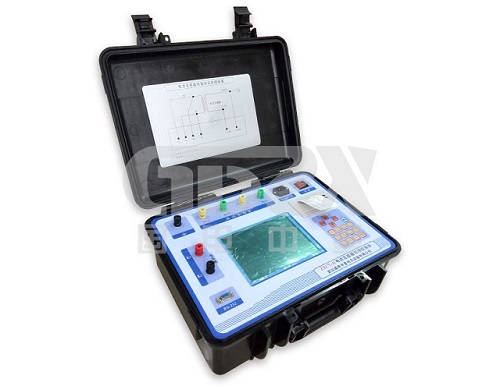NEWSnews
How To Choose A Current Transformer Tester?

Principles for selection and inspection of current transformers
(1) The rated voltage of the current transformer is not less than the rated voltage of the line at the installation point;
(2) According to the primary load calculation current IC to select the current transformer change;
(3) According to the requirements of the secondary circuit, select the accuracy of the current transformer and verify the accuracy;
(4) Verify the dynamic stability and thermal stability.
Selection of current transformer current ratio
The ratio of the primary rated current I1n and the secondary rated current I2n of the current transformer is called the rated current ratio of the current transformer, Ki = I1n/I2n≈N2/N1. In the type, N1 and N2 are the turns of the primary winding and secondary winding of the current transformer.
Current transformer primary measurement rated current standard ratio (such as 20, 30, 40, 50, 75, 100, 150(A), 2Xa/C) and other specifications, rated secondary current is usually 1A or 5A. Among them, 2Xa/C means that the same product has two current ratios. It is achieved by changing the connection method of the connecting piece outside the oil storage tank on the top of the product. When connected in series, the current ratio is a/c, and when connected in parallel, the current ratio is 2Xa/C. In general, the selection of the transformer current ratio of the measuring current transformer should be such that its primary rated current I1n is not less than the load current in the line (that is, the calculation IC). If the calculated current of the load in the line is 350A, the current transformer ratio should be selected as 400/5. In order to ensure the accuracy requirements of the current transformer for protection, the transformation ratio can be selected to be larger.
Selection and verification of current transformer accuracy
The so-called accuracy refers to the maximum error when the primary current is the rated value within the specified secondary load range. For different measuring instruments, current transformers with different accuracy should be selected.
The principle of accuracy selection: the accuracy of the current transformer used for billing measurement is 0.2 to 0.5; the ammeter used to monitor the magnitude of the load current in each inlet and outlet loop should be 1.0 to 3.0. current transformer. In order to ensure that the accuracy error does not exceed the specified value, the secondary load (volt-ampere) of the current transformer is generally verified. The secondary load S2 of the transformer is not greater than the rated load S2n, and the selected accuracy can be guaranteed. Accuracy verification formula: S2≤S2n. The load l of the secondary circuit: depends on the value of the impedance Z2 of the secondary circuit, then: S2 = I2n2︱Z2︱≈I2n2 (∑︱Zi︱+ RWl + RXC) or S2V1≈∑Si + I2n2 (RWl + RXC) In the formula, Si and Zi are the rated load and impedance of the instrument and relay coil in the secondary circuit, RXC is the contact resistance of all the connectors and contacts in the secondary circuit, generally 0.1Ω, and RWL is the resistance of the secondary circuit wire , The calculation formula is: RWL = LC / (r × S). In the formula, r is the conductivity of the wire, copper wire r = 53m / (Ωmm2), aluminum wire r = 32m (Ωmm2), S is the wire cross-sectional area (mm2), and LC is the calculated length of the wire (m). If the one-way length from the transformer to the instrument is L1, then: L1 transformer is star-connected LC = L1 two-phase V-shaped wiring 2L1 one-phase wiring.
The accuracy of current transformers used in relay protection are commonly 5P and l0P. The accuracy of the protection level is nominally based on the maximum composite error ε% at the rated accuracy limit primary current (eg ε% = 5% corresponding to 5P). The so-called rated accuracy limit primary current means that the primary current is a multiple of the rated primary current (n = I1 / I1n), also known as the rated accuracy limit factor. That is, the current transformer required for protection is within the possible range, and its maximum composite error does not exceed the value of ε%.
Calibration steps of current transformer ε% error curve
(1) Calculate the primary current multiple flowing through the current transformer according to the type of protection device;
(2) According to the model, transformation ratio and primary current multiple of the current transformer, determine the allowable secondary load of the current transformer on the 10% error curve;
(3) Calculate the actual secondary load of the current transformer according to the shortest type of the shortest load to the current transformer;
(4) Compare the actual secondary load with the allowable secondary load. If the actual secondary load is less than the allowable secondary load, it means that the error of the current transformer does not exceed 10% error: 1) increase the cross section of the connecting wire or shorten the length of the connecting wire to reduce the actual secondary load; 2) The current transformer reduces the primary current multiple and increases the allowable secondary load; 3) The secondary winding of the current transformer is connected in series to double the allowable secondary load.
Verification of dynamic stability and thermal stability of current transformer
Product technical parameters are given dynamic stability multiple Kes and thermal stability multiple Kt, so according to the following formula to verify dynamic stability and thermal stability.
(1) Dynamic stability verification Kes × I1N≥iSh;
(2) Thermal stability verification (KtI1n) 2t≥I (3) ∞tima Where t is the thermal stability current time.
GDZX is a manufacturer of power test equipment. For more products and more information, please contact sales1@gdzxdl.com for consultation!





















